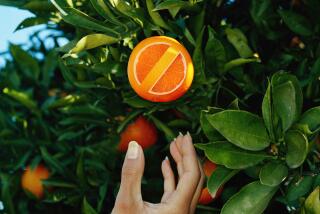Fruit Drop? Weather, Not Watering, Is the Likely Cause
- Share via
Weather wise, this has been an unusual year. We had summer back in winter and some pretty wintry weather in summer. Some things bloomed early, some late and then there is all the talk about fruit drop.
I am in the midst of a bumper crop myself. First there were more plums than even my kids could eat and now they are beginning to protest that they’re getting more than their share of peaches. We’ve had cobblers, upside-down cakes, and pies--peaches for breakfast, lunch and dinner--and still they come.
But others have been less fortunate. They lost much or all of their crop before it ripened. A certain amount of this is normal, even desirable, because the fruit that remains gets proportionately larger. Some drop, or thinning, is necessary on many trees.
Those that lost most or all of their crop should not blame themselves, or the tree. It was the weather. All of the deciduous fruit trees are marginal in Southern California because they really need more winter chilling than we can provide. There are areas that get the proper amount of cold, without too much summer heat, such as the west end of the San Fernando Valley, Ojai or the Hemet Valley. Most of the complaints about fruit drop come from people growing apricots, peaches or nectarines in the Los Angeles Basin, which includes all of Orange County.
Do Your Homework
Before buying a tree, do your homework on what varieties do well where you live. Sunset’s “Western Garden Book” or H. P. Books “Western Fruit, Berries and Nuts” can help. If you have a variety that fails to do well year after year, consider grafting another onto it, what is called “top working” in the orchard business. A good place to look for another, better-suited variety is in your neighbors’ back yards. Find a tree that has a record of producing well and when the winter pruning season arrives, beg a little wood to graft onto your tree. Grafting is surprisingly easy and there are many books on the subject.
Fruit drop is often attributed to erratic watering or too much fertilizer but these are unlikely causes according to Jim LaRue, tree fruit farm adviser for the University of California Cooperative Extension. Weather is more likely to cause fruit drop than watering. To be on the safe side, set up a regular watering schedule where the trees get a thorough soaking about every three to four weeks.






